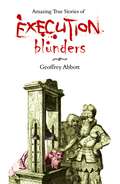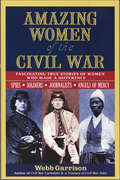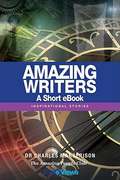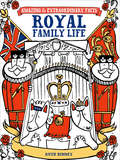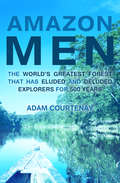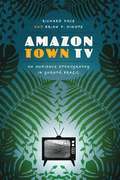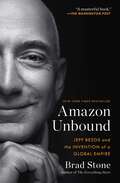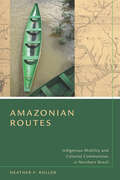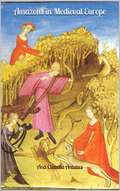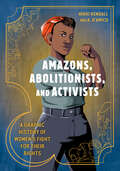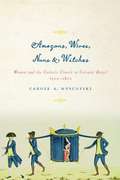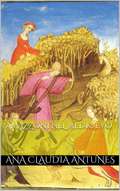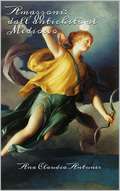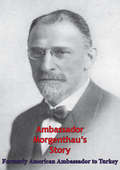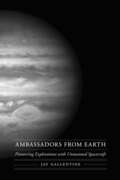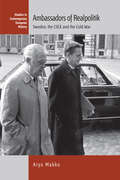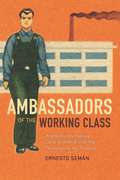- Table View
- List View
Amazing True Stories of Execution Blunders
by Geoffrey AbbottThe business of death can be seriously absurd, and nothing illustrates this better than these gruesome true tales. This gory compendium details the frankly ridiculous ways in which a number of ill-fated unfortunates met (or failed to meet) their maker at the hands of lamentably inept executioners. With black and white illustrations, this book brings together a mixture of bungled executions, strange last requests and classic one-liners from medieval times to the present day.
Amazing True Stories of Execution Blunders
by Geoffrey AbbottThe business of death can be seriously absurd, and nothing illustrates this better than these gruesome true tales. This gory compendium details the frankly ridiculous ways in which a number of ill-fated unfortunates met (or failed to meet) their maker at the hands of lamentably inept executioners. With black and white illustrations, this book brings together a mixture of bungled executions, strange last requests and classic one-liners from medieval times to the present day.
Amazing Women of the Civil War: Fascinating True Stories of Women Who Made a Difference . . .
by Webb GarrisonThe Civil War is most often described as one in which brother fought against brother. But the most devastating war fought on American soil was also one in which women demonstrated heroic deeds, selfless acts, and courage beyond measure. Women mobilized soup kitchens and relief societies. Women cared for wounded soldiers. Women were effective spies. And it is estimated that 300 women fought on the battlefields, usually disguised as men. The most fascinating Civil War women include:Harriet Tubman, a former slave, who led hundreds of fellow slaves to freedom on the Underground RailroadFour hundred women who were seized in Roswell, Georgia, deported to Indiana, and vanished without a traceBelle Boyd, the "Siren of the Shenandoah," who at the age of seventeen killed a Union soldier"Crazy" Elizabeth Van Lew, who deliberately fostered the impression that she was eccentric so that she could be an effective spy for the North"The poor fellow sprang from my hands and fell back quivering in the agonies of death. A bullet had passed between my body and the right arm which supported him, cutting through my sleeve and passing through his chest from shoulder to shoulder." ?Clara Barton, founder of the American Red Cross"We were all amused and disgusted at the sight of a thing that nothing but the debased and depraved Yankee nation could produce. [A woman] was dressed in the full uniform of a Federal surgeon. She was not good looking, and of course had tongue enough for a regiment of men." ?Captain Benedict J. Semmes, describing Mary Walker, M.D.
Amazing World War II Stories: Four Incredible True Tales (Amazing World War II Stories)
by Nel Yomtov Blake Hoena Bruce BerglundIn times of war, soldiers on the front lines must show their bravery. But acts of courage by some people aren't known until years after the fighting ends. From flying bombing missions in the dead of night, to tricking the enemy with fake encampments and unbreakable codes, to surviving horrific treatment by the enemy through sheer force of will, these incredible true tales will show how courage in war is often displayed by history's unsung heroes.
Amazing Writers - A Short eBook
by Charles MargerisonMost people enjoy reading in some form or other, be it newspapers or a heavy novel. This unique short story collection from The Amazing People Club explores the lives and achievements of some of the world's most influential writers, including Charles Dickens. Find out why he wrote his books and what inspired the characters which would become famous. Get a unique insight into the amazing life of William Shakespeare and his relationship with Anne Hathaway, his dreams of becoming a playwright in London, and how he worked to produce great plays like Hamlet and Romeo and Juliet. His story contrasts wonderfully with Mark Twain's, who has been deemed the 'father of american literature'. Get to know Twain as he travelled through the USA, from tiny towns in Missouri to the streets of New York. Each story comes to life through BioViews®. These are short biographical narratives, similar to interviews. They provide an easy way of learning about amazing people who made major contributions and changed our world.
Amazing and Extraordinary Facts: Royal Family Life (Amazing And Extraordinary Ser.)
by Ruth BinneyDelve into the more personal lives of the Royal family, past and present. From difficult childhoods to fashion icons, from love matches to divorces, and from unrehearsed coronations to assassination attempts and untimely deaths. Curiosity about Britain’s rulers and their next of kin never seems to wane, and it is this compendium about the lives of the members of the Royal Family that makes this so utterly compelling.
Amazing and Extraordinary Railway Facts
by Julian HollandWhat is the story behind the Mallard's speed record? Why did Brunel's atmospheric South Devon Railway fail? Who were the most famous locomotive engineers and designers? How did a locomotive manage to reach the summit of Snowdon Mountain in the 19th century? Travel through the enthralling history of British railways from the glorious age of steam right through to the present railway networks with this collection of fascinating and diverse facts and stories. Discover the world's oldest active steam locomotive before becoming up-to-date with railways in films, such as Harry Potter. In addition to fascinating lists of the longest tunnels, widest bridges and most powerful locomotives, ponder the dismal failure of Brunel's atmospheric railway in South Devon, before reading the rags-to riches tale of Frank Hornby. From the sublime to the ridiculous and the euphoric to the poignant, every railway enthusiast is catered for in Amazing and Extraordinary Railway Facts.
Amazon Men: The World's Greatest Forest that Has Eluded and Deluded Explorers for 500 Years
by Adam Courtenay“Captivating . . . An examination of complex and contradictory human responses to the development of the Amazon and to its preservation” (The Australian). Amazon Men is about conquistadors and botanists, colonizers and human rights activists, slave traders and philanthropists—that is, people who have variously tried to conquer, rework, map, enslave, and save this region and its river system, each according to the needs and zeitgeist of their time in history. The environmental battles of today are part of a long-running story that’s been going on since Europeans first discovered this impenetrable ocean of green. For centuries there’s been a war of attrition between the greatest ecosystem and the greatest predator. Up until now, the predator has failed. Amazon Men is about those who’ve tried to conquer and exploit the Amazon—and those who’ve tried to understand and savor it. Conquistadors Francisco de Orellana and Lope de Aguirre play their parts as representatives of the Age of Discovery. Charles Marie de La Condamine is a perfect foil for the Age of Enlightenment. Alexander von Humboldt appears as a scientist of the Romantic age, seeking unity in the midst of chaos. Walter Hardenburg represents the machine age, defying the industrial imperatives of his time to oppose unfettered colonial capitalism. Sydney Possuelo, the greatest living Amazonian explorer, represents the ongoing conflict between modern expansion and environmental causes. What do their experiences tell us about our attitude to the unexplored and unknown? The stories of Amazon Men recount deeds of bravery and acts of brilliance, but also forgotten holocausts where guns, germs, and steel have all played their roles.
Amazon Town TV: An Audience Ethnography in Gurupá, Brazil
by Richard Pace Brian P. HinoteIn 1983, anthropologist Richard Pace began his fieldwork in the Amazonian community of Gurupá one year after the first few television sets arrived. On a nightly basis, as the community’s electricity was turned on, he observed crowds of people lining up outside open windows or doors of the few homes possessing TV sets, intent on catching a glimpse of this fascinating novelty. Stoic, mute, and completely absorbed, they stood for hours contemplating every message and image presented. So begins the cultural turning point that is the basis of Amazon Town TV, a rich analysis of Gurupá in the decades during and following the spread of television. Pace worked with sociologist Brian Hinote to explore the sociocultural implications of television’s introduction in this community long isolated by geographic and communication barriers. They explore how viewers change their daily routines to watch the medium; how viewers accept, miss, ignore, negotiate, and resist media messages; and how television’s influence works within the local cultural context to modify social identities, consumption patterns, and worldviews.
Amazon Unbound: Jeff Bezos and the Invention of a Global Empire
by Brad StoneFrom the bestselling author of The Everything Store, an unvarnished picture of Amazon’s unprecedented growth and its billionaire founder, Jeff Bezos, revealing the most important business story of our time. <P><P>Almost ten years ago, Bloomberg journalist Brad Stone captured the rise of Amazon in his bestseller The Everything Store. Since then, Amazon has expanded exponentially, inventing novel products like Alexa and disrupting countless industries, while its workforce has quintupled in size and its valuation has soared to well over a trillion dollars. Jeff Bezos’s empire, once housed in a garage, now spans the globe. Between services like Whole Foods, Prime Video, and Amazon’s cloud computing unit, AWS, plus Bezos’s ownership of The Washington Post, it’s impossible to go a day without encountering its impact. <P><P>We live in a world run, supplied, and controlled by Amazon and its iconoclast founder. In Amazon Unbound, Brad Stone presents a deeply reported, vividly drawn portrait of how a retail upstart became one of the most powerful and feared entities in the global economy. <P><P>Stone also probes the evolution of Bezos himself—who started as a geeky technologist totally devoted to building Amazon, but who transformed to become a fit, disciplined billionaire with global ambitions; who ruled Amazon with an iron fist, even as he found his personal life splashed over the tabloids. Definitive, timely, and revelatory, Stone has provided an unvarnished portrait of a man and company that we couldn’t imagine modern life without.
Amazon.com
by Robert SpectorIn Amazon.com Jeff Bezos built something the world had never seen. He created the most recognized brand name on the Internet, became for a time one of the richest men in the world, and was crowned "the king of cyber-commerce."Yet for all the media exposure, the inside story of Amazon.com has never really been told. In this revealing, unauthorized account, Robert Spector, journalist and best-selling author, gives us this up-to-date, fast-paced, behind-the-scenes story of the company's creation and rise, its tumultuous present, and its uncertain future.
Amazonia: Five Years at the Epicenter of the Dot.com Juggernaut
by James MarcusA &“funny, contemplative&” memoir of working at Amazon in the early years, when it was a struggling online bookstore (San Francisco Chronicle). In a book that Ian Frazier has called &“a fascinating and sometimes hair-raising morality tale from deep inside the Internet boom,&” James Marcus, hired by Amazon.com in 1996—when the company was so small his e-mail address could be james@amazon.com—looks back at the ecstatic rise, dramatic fall, and remarkable comeback of the consummate symbol of late 1990s America. Observing &“how it was to be in the right place (Seattle) at the right time (the &’90s)&” (Chicago Reader), Marcus offers a ringside seat on everything from his first interview with Jeff Bezos to the company&’s bizarre Nordic-style retreats, in &“a clear-eyed, first-person account, rife with digressions on the larger cultural meaning throughout&” (Henry Alford, Newsday). &“Marcus tells his story with wit and candor.&” —Booklist, starred review
Amazonian Cosmopolitans: Navigating a Shamanic Cosmos, Shifting Indigenous Policies, and Other Modern Projects
by Suzanne OakdaleAmazonian Cosmopolitans focuses on the autobiographical accounts of two Brazilian Indigenous leaders, Prepori and Sabino, Kawaiwete men whose lives spanned the twentieth century, when Amazonia increasingly became the context of large-scale state projects. Both give accounts of how they worked in a range of interethnic enterprises from the 1920s to the 1960s in central Brazil. Prepori, a shaman, also gives an account of his relations with spirit beings that populate the Kawaiwete cosmos as he participated in these projects. Like other Indigenous Amazonians, Kawaiwete value engagement with outsiders, particularly for leaders and shamanic healers. These social engagements encourage a careful watching and learning of others&’ habits, customs, and sometimes languages, what could be called a kind of cosmopolitanism or an attitude of openness, leading to an expansion of the boundaries of community. The historical consciousness presented by these narrators centers on how transformations in social relations were experienced in bodily terms—how their bodies changed as new relationships formed. Amazonian Cosmopolitans offers Indigenous perspectives on twentieth-century Brazilian history as well as a way to reimagine lowland peoples as living within vast networks, bridging wide social and cosmological divides.
Amazonian Routes: Indigenous Mobility and Colonial Communities in Northern Brazil
by Heather F. RollerThis book reconstructs the world of eighteenth-century Amazonia to argue that indigenous mobility did not undermine settlement or community. In doing so, it revises longstanding views of native Amazonians as perpetual wanderers, lacking attachment to place and likely to flee at the slightest provocation. Instead, native Amazonians used traditional as well as new, colonial forms of spatial mobility to build enduring communities under the constraints of Portuguese colonialism. Canoeing and trekking through the interior to collect forest products or to contact independent native groups, Indians expanded their social networks, found economic opportunities, and brought new people and resources back to the colonial villages. When they were not participating in these state-sponsored expeditions, many Indians migrated between colonial settlements, seeking to be incorporated as productive members of their chosen communities. Drawing on largely untapped village-level sources, the book shows that mobile people remained attached to their home communities and committed to the preservation of their lands and assets. This argument still matters today, and not just to scholars, as rural communities in the Brazilian Amazon find themselves threatened by powerful outsiders who argue that their mobility invalidates their claims to territory.
Amazons In Medieval Europe
by Ana Bowlova Ana Claudia AntunesHow Amazons entered the imaginary to become legends? This book about the Amazons, the wiches, men and women in Medieval Europe, is like no other in the subject, since it´s a tale told in first person, as the author talks about it as a witness and protagonist in extremely realistic and original elements converged to give free access to past lives. You will expand your knowledge of the Middle Ages with first-person accounts about the Amazons, what they did, who they met, the risks and dangers suffering until became true living legends. A Tale highly engaging, moving and shocking at the same time that will make you wonder if all this was really true or just part of a collective soul. Dreams, fantasies, goddesses who lived on Earth long before it was colonized? Feel part of the world of Amazon in this book that reveals the synthesis of human knowledge within the collective consciousness. This is the second book of Memoirs of an Amazon Series. The Series include two more books: Amazons from Ancient to Medieval Times (Book 1) Amazons Today (Book 3) Happy reading / riding!
Amazons in America: Matriarchs, Utopians, and Wonder Women in U.S. Popular Culture
by Keira V. WilliamsWith this remarkable study, historian Keira V. Williams shows how fictional matriarchies—produced for specific audiences in successive eras and across multiple media—constitute prescriptive, solution-oriented thought experiments directed at contemporary social issues. In the process, Amazons in America uncovers a rich tradition of matriarchal popular culture in the United States. Beginning with late-nineteenth-century anthropological studies, which theorized a universal prehistoric matriarchy, Williams explores how representations of women-centered societies reveal changing ideas of gender and power over the course of the twentieth century and into the present day. She examines a deep archive of cultural artifacts, both familiar and obscure, including L. Frank Baum’s The Wizard of Oz series, Progressive-era fiction like Charlotte Perkins Gilman’s utopian novel Herland, the original 1940s Wonder Woman comics, midcentury films featuring nuclear families, and feminist science fiction novels from the 1970s that invented prehistoric and futuristic matriarchal societies. While such texts have, at times, served as sites of feminist theory, Williams unpacks their cyclical nature and, in doing so, pinpoints some of the premises that have historically hindered gender equality in the United States. Williams also delves into popular works from the twenty-first century, such as Tyler Perry’s Madea franchise and DC Comics/Warner Bros.’ globally successful film Wonder Woman, which attest to the ongoing presence of matriarchal ideas and their capacity for combating patriarchy and white nationalism with visions of rebellion and liberation. Amazons in America provides an indispensable critique of how anxieties and fantasies about women in power are culturally expressed, ultimately informing a broader discussion about how to nurture a stable, equitable society.
Amazons, Abolitionists, and Activists: A Graphic History of Women's Fight for Their Rights
by Mikki KendallA bold and gripping graphic history of the fight for women&’s rights by the New York Times bestselling author of Hood Feminism &“A beautifully drawn, hold-no-punches, surprisingly deep dive through the history of women's rights around the world, which will entrance kids and adults alike.&”—N. K. Jemisin, Hugo Award–winning author of the Broken Earth trilogy The ongoing struggle for women&’s rights has spanned human history, touched nearly every culture on Earth, and encompassed a wide range of issues, such as the right to vote, work, get an education, own property, exercise bodily autonomy, and beyond. Amazons, Abolitionists, and Activists is a fun and fascinating graphic novel–style primer that covers the key figures and events that have advanced women&’s rights from antiquity to the modern era. In addition, this compelling book illuminates the stories of notable women throughout history—from queens and freedom fighters to warriors and spies—and the progressive movements led by women that have shaped history, including abolition, suffrage, labor, civil rights, LGBTQ liberation, reproductive rights, and more. Examining where we've been, where we are, and where we're going, Amazons, Abolitionists, and Activists is an indispensable resource for people of all genders interested in the fight for a more liberated future.
Amazons, Wives, Nuns, and Witches: Women and the Catholic Church in Colonial Brazil, 1500-1822
by Carole A. MyscofskiThe Roman Catholic church played a dominant role in colonial Brazil, so that women's lives in the colony were shaped and constrained by the Church's ideals for pure women, as well as by parallel concepts in the Iberian honor code for women. Records left by Jesuit missionaries, Roman Catholic church officials, and Portuguese Inquisitors make clear that women's daily lives and their opportunities for marriage, education, and religious practice were sharply circumscribed throughout the colonial period. Yet these same documents also provide evocative glimpses of the religious beliefs and practices that were especially cherished or independently developed by women for their own use, constituting a separate world for wives, mothers, concubines, nuns, and witches. Drawing on extensive original research in primary manuscript and printed sources from Brazilian libraries and archives, as well as secondary Brazilian historical works, Carole Myscofski proposes to write Brazilian women back into history, to understand how they lived their lives within the society created by the Portuguese imperial government and Luso-Catholic ecclesiastical institutions. Myscofski offers detailed explorations of the Catholic colonial views of the ideal woman, the patterns in women's education, the religious views on marriage and sexuality, the history of women's convents and retreat houses, and the development of magical practices among women in that era. One of the few wide-ranging histories of women in colonial Latin America, this book makes a crucial contribution to our knowledge of the early modern Atlantic World.
Amazons: The History Behind the Legend
by David BraundThe idea of the Amazons is one of the most romantic and resonant in all antiquity. Greeks were fascinated by images and tales of these fierce female fighters. At Troy, Achilles' duel with Penthesilea was a clash of superman and superwoman. Achilles won the fight, but the queen's dying beauty had torn into his soul. This vibrant new book offers the first complete picture of the reality behind the legends. It shows there was much more to the Amazons than a race of implacable warrior women. David Braund casts the Amazons in a new light: as figures of potent agency, founders of cities, guileful and clever as well as physically impressive and sexually alluring to men. Black Sea mythologies become key to unlocking the Amazons' mystery. Investigating legend through history, literature, and archaeology, the author uncovers a truth as surprising and evocative as any fiction told through story or myth.
Amazzoni Nel Medioevo
by Ana Claudia Antunes Susanna CelottiCome sono entrate le Amazzoni nell'immaginario collettivo, diventando delle leggende? Questo libro sulle Amazzoni, le streghe, gli uomini e le donne dell'Europa medievale, è diverso da tutti gli altri in materia, dal momento che si tratta di un racconto narrato in prima persona, dove l'autrice è testimone diretta e protagonista di episodi estremamente realistici e originali che convergono in un libero accesso alle vite passate. Potrete ampliare la vostra conoscenza del Medioevo con un racconto vissuto in prima persona sulle Amazzoni, che cosa facevano, chi incontravano, quali rischi e pericoli correvano, come sono diventate vere e proprie leggende viventi. Un racconto molto coinvolgente, commovente e scioccante allo stesso tempo, che vi porterà a chiedervi se sia tutto vero o solo parte di un'anima collettiva. Sogni, fantasie, divinità che vivevano sulla Terra molto prima che fosse abitata? Sentitevi parte del mondo delle Amazzoni con questo libro che rivela la sintesi della conoscenza umana con la coscienza collettiva. Questo è il secondo libro della serie Memoria di un'Amazzone. La serie include altri due libri: Amazzoni: dall'antichità al Medioevo (Libro 1) Amazzoni oggi (Libro 3) Buona lettura e buon viaggio!
Amazzoni: Dall'antichità Al Medioevo
by Ana Claudia Antunes Susanna Celotti"Amazzoni: dall'antichità al Medioevo" è il primo libro della trilogia "Memorie di un'Amazzone". Più che una favola, o una storia d'amore, o un racconto d'avventura o d'azione, "Memorie di un'Amazzone" è una raccolta di lezioni di storia, anzi di Storia con la maiuscola, che attraversano gli abissi del tempo e sfidano le profondità dell'esistenza. E forse ancora di più, sono intensi racconti in prima persona, capaci di scivolare nell'essenza stessa di una vita vissuta tra le battaglie, di condividere scene estremamente realistiche, indimenticabili e anche un po' surreali, di rivelare misteri finora mai svelati, fra le cronache del passato e dei momenti cruciali della storia del genere umano. Con uno sguardo semplice ma allo stesso tempo impietoso sulla distruzione della propria stessa esistenza, questo libro riporta documenti reali sulla vita in modo chiaro e puntuale, non tralasciando concetti come il folklore e la mitologia, ma rivelando questioni fondamentali riguardanti il riconoscimento storico del ruolo della donna nella società.
Ambassador Morgenthau’s Story [Illustrated Edition]
by Henry MorgenthauIllustrated with 54 photographs and portraits.The memoirs of the American Ambassador to Turkey during the First World War, covering the political dealing at the top of the Ottoman Empire and the events of the Armenian disaster.The Memoirs of Henry Morgenthau Sr. cover the period that he was in office as United States Ambassador to the Ottoman Empire; his memoirs reflect on the two moments events that characterized the period. The first event was of course World War that raged on throughout his tenure and he records how he sought to ensure the safety of the American citizens in the Empire as well as serving as much as possible the interests of the Allied nations whose embassies had been withdrawn. His anecdotes of the German and Turkish generals and ministers who inhabited the highest echelons are well worth reading and a rarity in English.The Second event was the Armenian massacres which are now overshadowed by the Holocaust of the Jews during the Second World War, however the suffering of the Armenian minority that were targeted by the Ottoman Empire's policy was just as great a crime against humanity; indeed the very word 'Genocide' was coined to describe this terrible period. Few books in English describe the awful suffering of this period of the First World War, however the author wrote voluminously of the incidents and even toured the affected areas. His memoirs are perhaps the best first-hand details of this terrible event by a neutral outsider, on an issue that remains contentious to this day.
Ambassadors from Earth: Pioneering Explorations with Unmanned Spacecraft (Outward Odyssey: A People's History of Spaceflight)
by Jay GallentineRewind to the 1950s and ponder: was America&’s first satellite really built by a college student? How did a small band of underappreciated Russian engineers get pictures of the moon&’s far side—using stolen American film? As the 1960s progressed, consider: how the heck did people learn to steer a spacecraft using nothing but gravity? And just how were humans able to goose a spaceship through a thirty-year journey to the literal edge of our solar system? Ambassadors from Earth relates the story of the first unmanned space probes and planetary explorers—from the Sputnik and Explorer satellites launched in the late 1950s to the thrilling interstellar Voyager missions of the '70s—that yielded some of the most celebrated successes and spectacular failures of the space age. Keep in mind that our first mad scrambles to reach orbit, the moon, and the planets were littered with enough histrionics and cliffhanging turmoil to rival the most far-out sci-fi film. Utilizing original interviews with key players, bolstered by never-before-seen photographs, journal excerpts, and primary source documents, Jay Gallentine delivers a quirky and unforgettable look at the lives and legacy of the Americans and Soviets who conceived, built, and guided those unmanned missions to the planets and beyond. Of special note is his in-depth interview with James Van Allen, the discoverer of the rings of planetary radiation that now bear his name. Ambassadors from Earth is an engaging bumper-car ride through a fog of head-banging uncertainty, bleeding-edge technology, personality clashes, organizational frustrations, brutal schedules, and the occasional bright spot. Confessed one participant, &“We were making it up as we went along.&”
Ambassadors of Realpolitik: Sweden, the CSCE and the Cold War (Contemporary European History #20)
by Aryo MakkoDuring the Cold War, Sweden actively cultivated a reputation as the “conscience of the world,” working to build bridges between East and West and embracing a nominal commitment to international solidarity. This groundbreaking study explores the tension between realism and idealism in Swedish diplomacy during a key episode in Cold War history: the Conference on Security and Cooperation in Europe, culminating in the 1975 Helsinki Accords. Through careful analysis of new evidence, it offers a compelling counternarrative of this period, showing that Sweden strategically ignored human rights violations in Eastern Europe and the nonaligned states in its pursuit of national interests.
Ambassadors of the Working Class: Argentina's International Labor Activists and Cold War Democracy in the Americas
by Ernesto SemánIn 1946 Juan Perón launched a populist challenge to the United States, recruiting an army of labor activists to serve as worker attachés at every Argentine embassy. By 1955, over five hundred would serve, representing the largest presence of blue-collar workers in the foreign service of any country in history. A meatpacking union leader taught striking workers in Chicago about rising salaries under Perón. A railroad motorist joined the revolution in Bolivia. A baker showed Soviet workers the daily caloric intake of their Argentine counterparts. As Ambassadors of the Working Class shows, the attachés' struggle against US diplomats in Latin America turned the region into a Cold War battlefield for the hearts of the working classes. In this context, Ernesto Semán reveals, for example, how the attachés' brand of transnational populism offered Fidel Castro and Che Guevara their last chance at mass politics before their embrace of revolutionary violence. Fiercely opposed by Washington, the attachés’ project foundered, but not before US policymakers used their opposition to Peronism to rehearse arguments against the New Deal's legacies.
